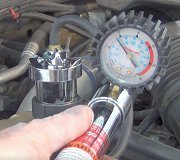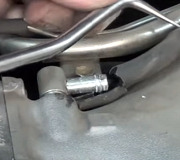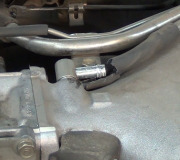Hello .. thanks for the donation ..much appreciated
The best way to make sure the leak is repaired correctly is to complete all parts of the TSB repair .. you can opt of course to just replace the intake manifold upper/lower gasket's !!
4.0L COOLANT LOSS - REVISED INTAKE MANIFOLD GASKET
TECHNICAL SERVICE BULLETIN
Reference Number(s): 95-9-10, Date of Issue: May 8, 1995
Related Ref Number(s): 95-9-10
ARTICLE BEGINNING
CONDITIONS
COOLING SYSTEM - LOSS OF COOLANT -4.0L ENGINE - REVISED INTAKE MANIFOLD GASKET AND INSTALLATION PROCEDURE
LEAKS - COOLANT -4.0L ENGINE - REVISED INTAKE MANIFOLD GASKET AND INSTALLATION PROCEDURE
APPLICATION
Model(s): Ford Light Truck: 1992-94 Aerostar, Explorer, Ranger
Bulletin No.: 95-9-10
Date: May 8, 1995
ISSUE
Coolant loss, with no visible sign of leakage, may occur on some vehicles. This may be due to internal leaks from a failed intake manifold gasket caused by loose intake manifold bolts, a fouled intake manifold, pitting/corrosion, or loose cylinder head bolts.
ACTION
Refer to the following procedures for service details.
NOTE:Due to air being trapped in the cooling system, it is not unusual to add 4-7 oz (118-207 ml) coolant up to 7500 miles (12,000 km) after initial fill.
INSPECTION PROCEDURE
Run the engine for 10 minutes, or as required, to build pressure in the cooling system for a leak inspection. Examine the radiator, side tanks, coolant recovery bottle, hoses and connections, intake manifold, cylinder heads and block for external coolant leaks. If no external leak can be found, then the concern may be with the lower intake manifold gasket, intake manifold pitting/corrosion, or with low cylinder head bolt torque.
Measure the cylinder head bolt torque. If torque is less than 80 Nm (59 lb-ft), replace Cylinder Head Gasket (F5TZ-6051-A RH, and F5TZ-6051-B LH) using the procedure in this TSB article.
If coolant loss continues, even with proper head bolt torque, remove intake manifold and remove all old gasket material and any coolant residue with a soft non-metallic or aluminum wire brush. Inspect manifold for corrosion/erosion/pitting damage at the four (4) water passages. See Fig. 1 . If damaged, the intake manifold must be replaced.
CAUTION:Do not use a sand disk or similar power tool. If the intake manifold surface is pitted (Fig. 1 ), then the manifold must be replaced.
Replace the lower intake manifold gasket with the new Carrier-type Intake Manifold Gasket (F5TZ-9439-A). Use the procedures found in this TSB article.
DISASSEMBLY PROCEDURE INTAKE AND CYLINDER HEAD GASKETS
Service the intake manifold (lower) and cylinder head gaskets per the appropriate Powertrain/Drivetrain Service Manual, when required.
INSTALLATION ASSEMBLY PROCEDURE AFTER REMOVING BOTH CYLINDER HEAD AND INTAKE MANIFOLD
Remove all old gasket material with a soft non-metallic or aluminum wire brush.
CAUTION:Do not use a sand disk or similar power tool.
Before installing the new gasket, remove all old sealer from the intake, heads and block surfaces, and check for proper condition. Clean all exposed areas very thoroughly with Metal Surface Cleaner (F4AZ-19A536-RA) or denatured alcohol.
NOTE:The 4.0L engine should always be assembled using new cylinder head bolts.
Position cylinder head gaskets on cylinder block. Install cylinder head locating dowels. Position the cylinder heads onto the gaskets and locating dowels. See Fig. 4 .
NOTE:If the engine received has bolts instead of guide studs (as in item 3, Fig. 6 ), then temporarily replace bolts with guide studs (E805676-S72). If guide studs are not in stock, fabricate by removing the heads from two (2) bolts (W700166-S309). install them snugly in the cylinder block holes that match holes 3 and 4 (Fig. 7 ). if guide studs were on the vehicle received, then loosen the studs 1/2 turn before proceeding.
NOTE:The cylinder head(s) and intake manifold are torqued alternately and in sequence to ensure correct fit and gasket crush. Failure to follow complete torque sequence will cause follow-up repair.
Install and torque cylinder head bolts, in the sequence shown, to 30 Nm (22 lb-ft). See Fig. 5 .
NOTE:The silicone sealer, applied in the following step, will set-up in approximately 15 minutes. The intake manifold must be installed immediately after the sealer is applied.
Apply a small amount (peanut size) of Silicone Rubber Sealer, Loctite 598 (F1AZ-19562-A) on the bottom side of the gasket at the four (4) corners. See Fig. 2 . The sealer should be applied between the ridges. See Fig. 2 .
Position the gasket with the help of the two (2) temporary guide studs (Item 3, Fig. 6 ) located in Positions 3 and 4 (Fig. 7 ), and slide the gasket down to its final position in the valley. Then apply a small amount (peanut size) of Silicone Rubber Sealer, Loctite 598 (F1AZ-19562-A) on the top side of the gasket at the four (4) corners between the ridges. See Fig. 2 .
NOTE:If intake manifold replacement is required as determined from earlier inspection procedure, and when replacing with a 1995 manifold, different manifold bolts are to be used as when replacing with a previous year manifold. Also, an additional torque step is required with the 1992-94 manifold. The 1995 manifold can be identified by two methods: (1) the blue dot beneath the suffix of part number FOTZ-9424-A, (2) the spotface areas as per Fig. 8 . use this method if no blue dot is visible.
Position the lower intake manifold on the two (2) guide studs and install the nuts and bolts hand tight. See Fig. 6 and Fig. 8 for proper bolt selection, depending on the manifold year. Torque the intake manifold bolts, in sequence, to 4 Nm (3 lb-ft). See Fig. 7 . Replace the two (2) studs with bolts (save the studs for use when necessary on future jobs).
NOTE:Model year 1995 bolts with captive washers are not usable on intake manifolds of previous model years.
Torque the cylinder head bolts, in sequence, to 70 Nm (52 lb-ft). See Fig. 5 .
Torque the intake manifold bolts, in sequence, to 8 Nm (6 lb-ft). See Fig. 7 .
For the final cylinder head torque step, rotate the cylinder head bolts 90 degrees in sequence. See Fig. 5 .
If using bolts with a captive washer (1995 manifold), finish tightening the intake manifold, in sequence, to 15 Nm (11 lb-ft). If using bolts without a captive washer 1990-94 manifold), tighten an additional step to 21 Nm (15 lb-ft).
Install the valve push rods. Install the rocker arms as outlined in the Service Manual.
Install the valve covers as outlined in "VALVE COVER AND GASKET INSTALLATION PROCEDURE" in this TSB article.
INSTALLATION PROCEDURE AFTER REMOVING ONLY THE INTAKE MANIFOLD
Before installing the new gaskets, remove all old sealer from the intake, heads and block surfaces, and check for proper surface condition. Clean all exposed areas very thoroughly with Metal Surface Cleaner (F4AZ-19A536-RA) or denatured alcohol.
CAUTION:Do not use a sand disk or similar power tool. If the intake manifold surface is pitted (Fig. 1 ), then the manifold must be replaced.
NOTE:If the engine received has bolts instead of guide studs (item 3, Fig. Fig. 6 ), then temporarily replace bolts with guide studs (W701104-S309). If guide studs are not in stock, fabricate by removing the heads from two (2) bolts (W700166-S309). Install them snugly in the cylinder block holes that match holes 3 and 4 (Fig. 7 ). If guide studs were on the vehicle received, then loosen the studs 1/2 turn before proceeding.
NOTE:The silicone sealer, applied in the following step, will set-up in approximately 15 minutes. The intake manifold must be installed immediately after the sealer is applied.
Apply a small amount (peanut size) of Silicone Rubber Sealer, Loctite 598 (F1AZ-19562-A) on the bottom side of the gasket at the four (4) corners. See Fig. 2 . The sealer should be applied between the ridges. See Fig. 2 .
Position the gasket with the help of the two (2) temporary guide studs (Item 3, Fig. 6 ) located in positions 3 and 4 (Fig. 7 ), and slide the gasket down to its final position in the valley. Then apply a small amount peanut size) of Silicone Rubber Sealer, Loctite 598 (F1AZ-19562-A) on the top side of the gasket at the four (4) corners between the ridges. See Fig. 2 .
NOTE:If intake manifold replacement is required as determined from earlier inspection procedure, and when replacing with a 1995 manifold, different manifold bolts are to be used as when replacing with a previous year manifold. Also, an additional torque step is required with the 1992-94 manifold. The 1995 manifold can be identified by two methods: (1) the blue dot beneath the suffix of part number FOTZ-9424-A, (2) the spotface areas as per Fig. 8 . Use this method if no blue dot is visible.
Position the lower intake manifold on the two (2) guide studs and install the nuts and bolts hand tight. See Fig. 6 and Fig. 8 for proper bolt selection, depending on the manifold year. Tighten the intake manifold in stages using the following torques and the sequence shown in Fig. Fig. 7 .
4 Nm (3 lb-ft)
NOTE:Replace the two (2) studs with bolts (save the studs for use when necessary on future jobs).
8 Nm (6 lb-ft)
15 Nm (11 lb-ft)
NOTE:Stop here if the intake manifold being installed is a 1995 (blue dot beneath the suffix of part number FOTZ-9424-A or wide area for the bolt hole spotface). The following step applies only to prior year manifolds.
21 Nm (15 lb-ft)
NOTE:Model year 1995 bolts with captive washers are not usable on intake manifolds of previous model years.
Install the valve covers as outlined in "VALVE COVER AND GASKET INSTALLATION PROCEDURE" in this TSB article.
VALVE COVER AND GASKET INSTALLATION PROCEDURE
Clean valve cover, intake manifold, cylinder head gasket surfaces and threaded bolt holes.
NOTE:Since silicone rubber sealant will set-up in 15 minutes, apply to one (1) valve cover at a time, if you are installing both covers.
Apply a small amount (peanut size) of Silicone Rubber Sealant, Loctite 598 (F1AZ-19562-A), or equivalent, to:
The four (4) manifold locations at the joint where the intake manifold and the cylinder heads meet. See Fig. 3 , Position A.
Any casting irregularity on the gasket sealing area of the cylinder head(s).
NOTE:If 1992 vehicles have valve cover gaskets of the cork type, these gaskets must be replaced with metal-type (carrier) gasket. The new type gasket is a thinner gasket, therefore to prevent bottoming it is important to re-use the conical spring washer screws (W700099-S309M), M6 x 20 mm, together with reinforcements (flange plates), -6A523-; and stud (E804194-S72), M6 x 20/M6 x 20, w/o washer, and with reinforcement, -6A523-. See Fig. 3 . Also, see TSB 92-14-13.
CAUTION:Check for bottoming to ensure correct parts were installed during previous repair. Any failure to use correct fasteners can result in an oil leak and a repeat repair. Also check for visible flatness of the valve cover rail using a straight edge. An out of flat rail will require a valve cover replacement, or repair.
NOTE:Later model year vehicles (late 1992 and 1993 through current), should have carrier gaskets already installed, with short screws (W701035-S300), M6 x M16 mm, with conical spring washers; and studs (W701041-S300), M6 x 16/M6 x 16 mm with conical spring washers; and should not have reinforcements. Check that this hardware was installed and then re-use fasteners.
NOTE:Stud goes in upper rear hole. Ensure bolt holes are clean and free of oil residue.
Install valve cover, rocker arm cover flange plates and bolts. Tighten bolts starting from center bolts and working in crisscross pattern to end bolts. Torque in the same pattern to 6-8 Nm (53-71 lb-in). See Fig. 3 . Also, see TSB 92-14-13.
Continue reassembly per procedures in appropriate year Service Manual.
Fill cooling system using the "FILLING AND BLEEDING THE COOLANT SYSTEM" procedure in this TSB article.
FILLING AND BLEEDING THE COOLANT SYSTEM
WARNING:Never remove the radiator cap under any conditions while the engine is operating. Failure to follow this instruction could result in damage to the cooling system or engine and/or cause personal injury. Use extreme care when removing the radiator cap from a hot radiator. If possible, wait until engine has cooled, then wrap a thick cloth around the radiator cap and turn it slowly to the first stop. Step back while the pressure is released from the cooling system. When you are sure all the pressure has been released, press down on the radiator cap (still using a cloth), turn and remove it.
In order to bleed the cooling system properly after an initial fill with coolant, it might need up to five (5) cycles of the following:
Heating up the system (thermostat open).
Ensuring coolant is at least up to the "cold" fill mark of the overflow bottle.
Letting coolant cool down (temperature gauge below "N" of normal).
Topping off coolant overflow to "cold" mark.
Repeating cycle.
FILLING
WARNING:Use caution when adding coolant mixture to radiator to avoid hot coolant or steam blow out from the radiator.
NOTE:Use the following steps to remove air from the cooling system and to ensure a complete fill can be accomplished.
NOTE:When filling a crossflow radiator, allow time for the coolant to flow through the radiator tubes to the other end tank to ensure radiator is full.
Close radiator draincock and install cylinder block drain plug.
Fill the cooling system with a 50/50 ethylene glycol and water mixture. Allow several minutes for trapped air to escape (bubble out) and for coolant mixture to flow through the radiator.
Install radiator cap to pressure relief position by installing radiator cap to fully-installed position and then backing off to first stop. This will allow any air to escape and minimize spillage.
Slide heater temperature and mode selection levers to maximum heat position.
Start engine and allow to operate at fast idle (approximately 2000 rpm) for 3 to 4 minutes. Shut engine off.
With engine off, rap radiator cap with a thick cloth, carefully remove radiator cap and add coolant to bring coolant level up to filler neck seat.
Replace radiator cap to fully-installed position. Then, back off to first stop. Operate engine at fast idle until the upper radiator hose is warm (water thermostat opens). To check radiator, Shut engine off, wrap radiator cap with thick cloth and carefully remove radiator cap. Add additional coolant if necessary. Replace radiator cap to fully-installed position.
Open the small cap on the top of the radiator coolant recovery reservoir. The large cap is for the windshield washer reservoir. NEVER put coolant mixture in windshield washer bottle.
Using a suitable suction gun, remove all coolant from radiator coolant recovery reservoir.
Add 1 liter (1.1 quart) of 50/50 mixture of ethylene glycol and water to the radiator coolant recovery reservoir. Close small cap.
NOTE:Model year 1995 bolts with captive washers are not usable on previous model year intake manifolds. Use bolts W700166-S309 with 1992-94 manifolds, and use bolts W702301-S309M with 1995 manifolds. 1995 manifolds may be identified by two methods: (1) the blue dot beneath the suffix of part number FOTZ-9424-A. (2) the spotface areas as per Fig. 8 . Use this method if no blue dot is visible.
Hope this helps.

SPONSORED LINKS
Monday, March 1st, 2010 AT 4:28 AM





